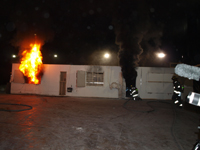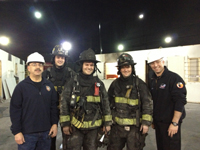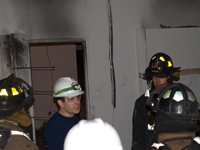
| Archives/Subscribe | Printer Friendly | Send to a Friend | Advertise | NYS Fire Chiefs | Size Up | March 2016 | |||||
UL Research Aims to Determine Best Methods to Attack Modern House Fires
By Jerry Knapp  House fires are our most important alarm. 80 percent of all civilian fire deaths nationwide are the result of home fires. On average, eight Americans lose their lives each day in residential fires. NFPA estimates that $7 billion in property loss occurs annually in the United States due to residential fires. Underwriters Laboratories (UL), the same folks whose label we look for to insure the safety of common items such as electrical extension cords and computer power strips, has been conducting world class grant funded research to determine the best methods to attack modern house fires. The most recent $1.5 million U.S. Department of Homeland Security Fire Prevention and Safety (FP&S) Research and Development Grant (R&D) study is titled, "Study of the Impact of Fire Attack Utilizing Interior and Exterior Streams on Firefighter Safety and Occupant Survival." The leaders of this research team assume their firefighter roles and will actually be executing hoseline advances into the instrumented live burns. Pictured above: a fully furnished 1,600-square-foot house is located in the UL large fire facility at UL headquarters in Northbrook, Ill. and is being used in these studies. The study has incorporated 25 firefighters from across the world into a technical panel that is responsible for helping UL ensure the study is grounded in real world firefighting operations. The technical panel is invited to witness the live burns to help the highly professional research team with evaluations and recommendations aimed at keeping the study useful for fire departments. One of leading researchers in the study is Robin Zevotek, who has deep roots in New York. He was a firefighter with the Chenango Bridge Fire Department for three years and was also a firefighter and captain with the Moyers Corners Fire Department for seven years before he left to begin work with the UL Firefighter Safety Research Institute (FSRI). Zevotek’s responsibilities in the live burns include directing the team members to coordinate timing of ventilation, fire suppression operations, and data collection. Approximately 30 live fire suppression operations were conducted over the course of 25 days in March 2016. With their extensive backgrounds and knowledge of the fire service, all of the researchers understand the critical issues facing firefighters at modern house fires. During the live burns, data is collected on the following parameters: temperature, humidity, heat release rate, heat flux, and gas concentrations (oxygen, carbon monoxide, and carbon dioxide) throughout the home. Analysis of this huge amount of information (300 MB of data and over 40 GB of video from each burn) will later be plotted on graphs to determine the positive or negative effect of different hose/nozzle streams and techniques on fire suppression, victim survival, and of course, firefighter safety. Results of this ongoing project will be available in 2017. More information and excellent free, self-paced online training programs that are the result of previous research projects are available from UL. Click here for the UL Firefighter Safety Research Institute site and here for training information. Information is also available from the Modern Fire Behavior website and from International Society of Fire Service Instructors (ISFSI) website.   Above (left): Researchers and technical panel members during the live burn portion of the research. Pictured, L to R: Jerry Knapp, technical panel member; Fire Protection Engineer and Director Steve Kerber, UL Firefighter Safety Research Institute (FSRI) at Underwriters Laboratories; FSRI Fire Protection Engineer Keith Stakes, the nozzle man for the 25 instrumented live burns and a lieutenant with the Bethesda-Chevy Chase (MD) Rescue Squad; Research Associate Mike Alt, the back-up man for the interior attacks and a FSRI laboratory technician; and Steve Brisebois, technical panel member and captain with the Montreal (Canada) Fire Department. Above (right): Robin Zevotek prepares the team for a live burn. Photos by Bill Quinn, Westwood (NJ) Fire Department. About the Author: Jerry Knapp is a 40-year veteran firefighter/EMT with the West Haverstraw Fire Department and is employed as a training officer at the Rockland County Fire Training Center. He is chief of the Rockland County Haz-Mat Task Force, a former nationally certified paramedic, and holds a degree in fire protection. Knapp is the author of the fire attack chapter in Fire Engineering’s Handbook for Firefighter I & II and numerous articles in fire service trade journals. He has also presented training programs on a variety of topics. Knapp serves on the technical panel for the latest Underwriters Laboratories FEMA grant to study the effects of interior and exterior streams at house fires. |
|
New York State Association of Fire Chiefs www.nysfirechiefs.com |
1670 Columbia Turnpike | P.O. Box 328 East Schodack, NY 12063-0328 Phone: (800) 676-FIRE | (518) 477-2631 Fax: (518) 477-4430 |



